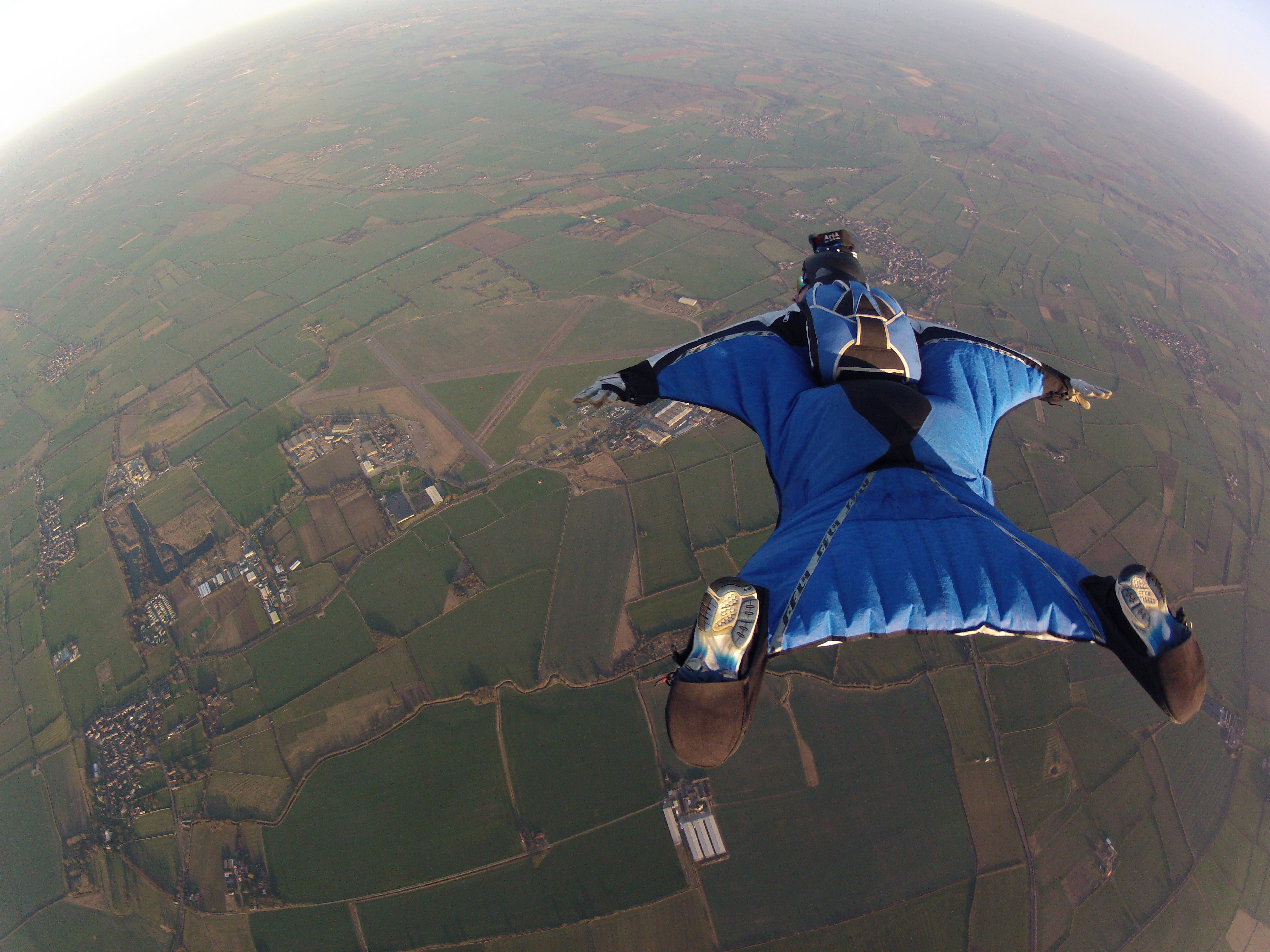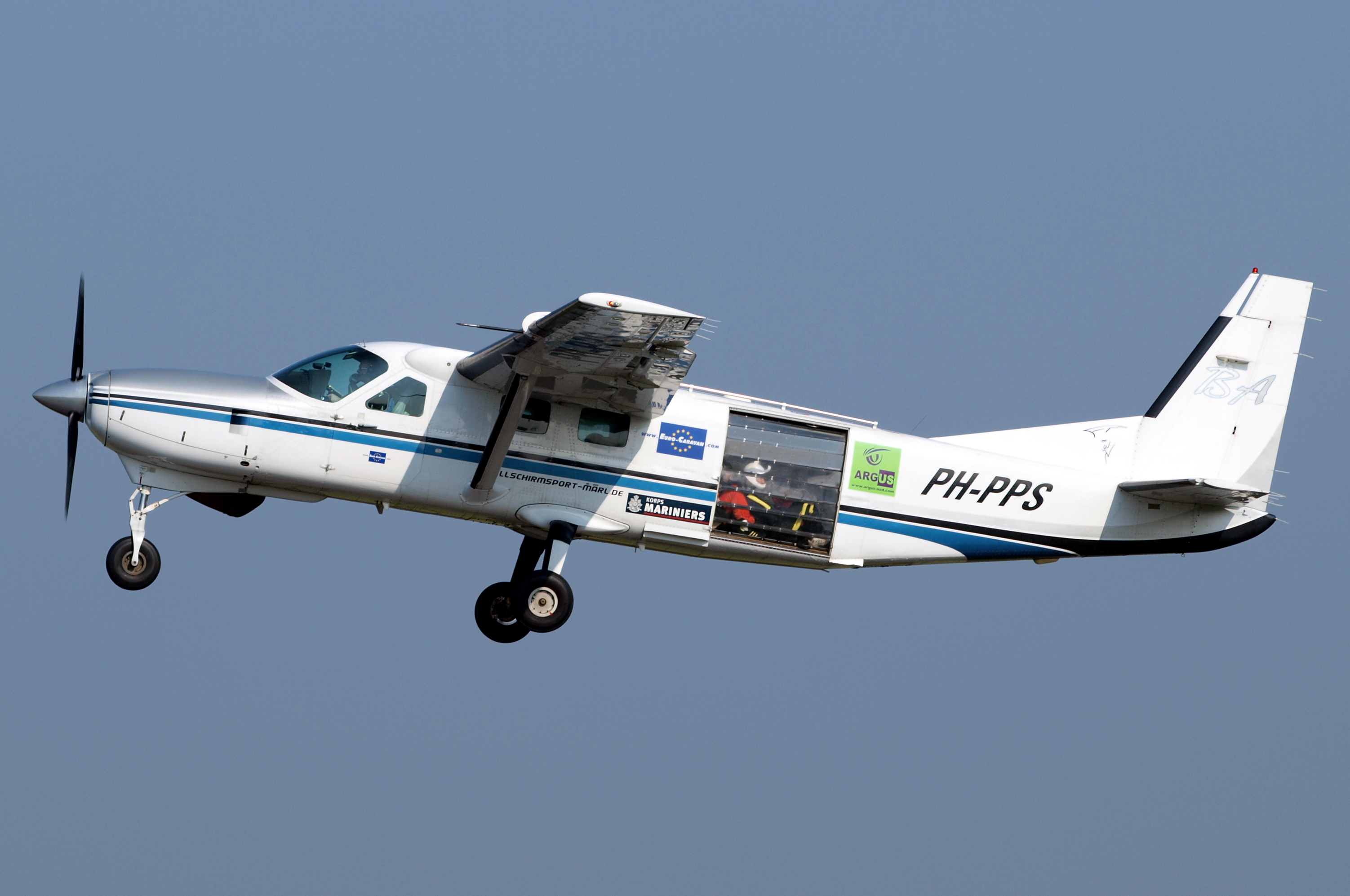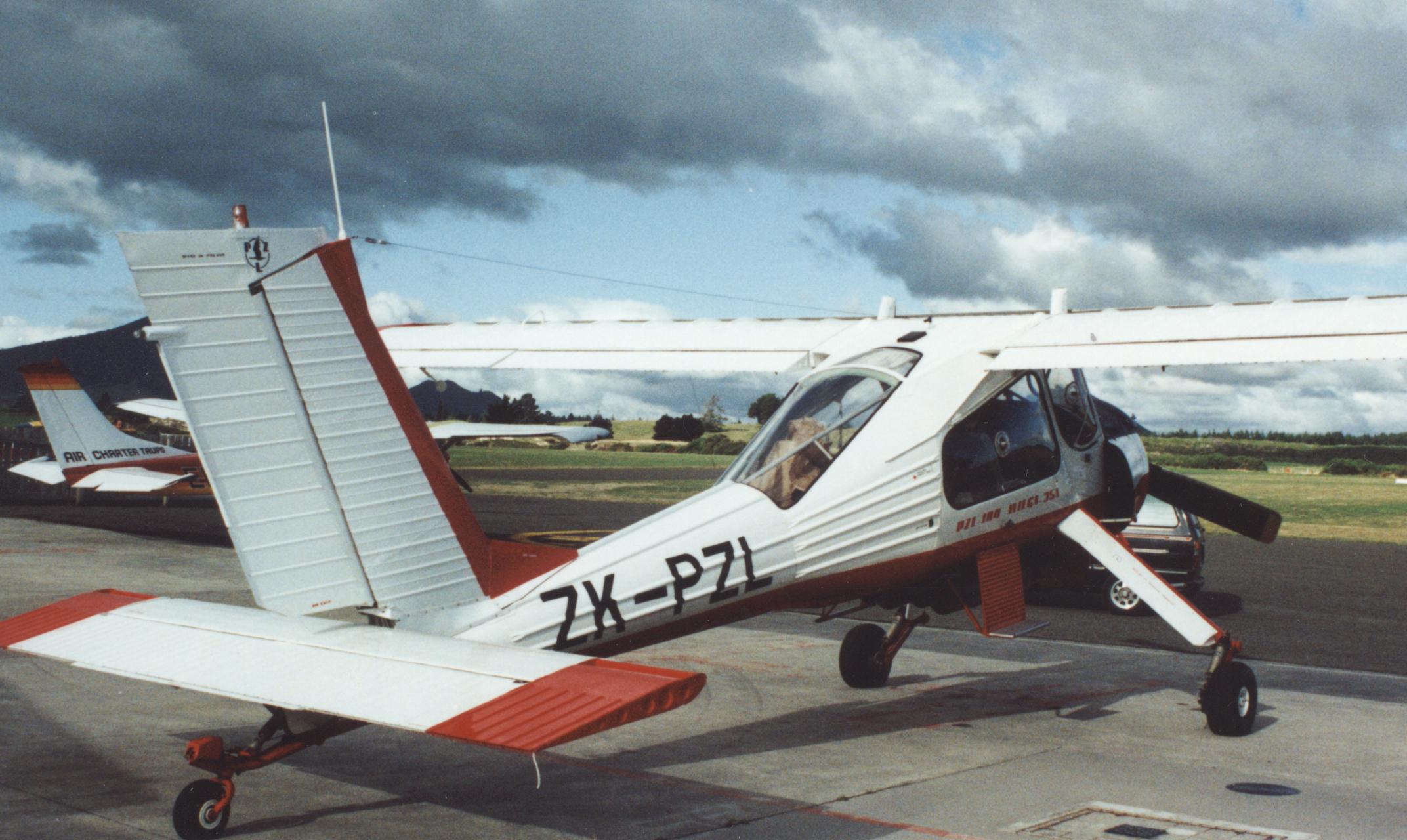|
Airplane Wingsuit Formation
Airplane wingsuit formation (AWF) is a sub‑discipline of wingsuit flying in which wingsuit pilots exit an aircraft or jump from a cliff and fly a predetermined formation in close proximity to the jump plane. Developed from experimental stunts in the late 1990s, AWF matured in the 2010s into an organised niche of air‑sports with documented record attempts and safety protocols. History Pioneering flights (1997 – 2016) * In July 1997 French wingsuit pioneer Patrick de Gayardon jumped from a Pilatus PC-6 Porter over Chamonix and—after a short glide—flew back into the same aircraft, demonstrating the first documented “plane‑re‑entry” with a modern wingsuit. * Between 2013 and 2016 several European wingsuit teams conducted informal formation flights alongside Pilatus PC-6 and Cessna jump planes in France and Spain, laying the groundwork for standardised exit order, reference speeds and vertical separation. Coverage of those early gatherings appeared in ' ... [...More Info...] [...Related Items...] OR: [Wikipedia] [Google] [Baidu] |
Wingsuit Flying
Wingsuit flying (or wingsuiting) is the sport of skydiving using a webbing-sleeved jumpsuit called a wingsuit to add webbed area to the diver's body and generate increased lift, which allows extended air time by gliding flight rather than just free falling. The modern wingsuit, first developed in the late 1990s, uses a pair of fabric membranes stretched flat between the arms and flanks/thighs to imitate an airfoil, and often also between the legs to function as a tail and allow some aerial steering. Like all skydiving disciplines, a wingsuit flight almost always ends by deploying a parachute, and so a wingsuit can be flown from any point that provides sufficient altitude for flight and parachute deployment – a drop aircraft, or BASE-jump exit point such as a tall cliff or mountain top. The wingsuit flier wears parachuting equipment specially designed for skydiving or BASE jumping. While the parachute flight is normal, the canopy pilot must unzip arm wings (after deployme ... [...More Info...] [...Related Items...] OR: [Wikipedia] [Google] [Baidu] |
Cessna 208 Caravan
The Cessna 208 Caravan is a utility aircraft produced by Cessna. The project was commenced on November 20, 1981, and the prototype first flew on December 9, 1982. The production model was certified by the FAA in October 1984 and its Cargomaster freighter variant was developed for FedEx. The longer 208B Super Cargomaster first flew in 1986 and was developed into the passenger 208B Grand Caravan. The strutted, high wing 208 typically seats nine passengers in its unpressurized cabin, is powered by a single Pratt & Whitney Canada PT6A tractor turboprop and has a fixed tricycle landing gear, floats, or skis. By 2022, 3,000 had been delivered and 24 million flight hours have been logged. Caravans have been used for flight training, commuter airlines, VIP transport, air cargo, skydiving and humanitarian missions. Development On November 20, 1981, the project was given a go-ahead by Cessna for its Pawnee engineering facility. John Berwick, chief engineer at Pawne ... [...More Info...] [...Related Items...] OR: [Wikipedia] [Google] [Baidu] |
Wingsuit Flying
Wingsuit flying (or wingsuiting) is the sport of skydiving using a webbing-sleeved jumpsuit called a wingsuit to add webbed area to the diver's body and generate increased lift, which allows extended air time by gliding flight rather than just free falling. The modern wingsuit, first developed in the late 1990s, uses a pair of fabric membranes stretched flat between the arms and flanks/thighs to imitate an airfoil, and often also between the legs to function as a tail and allow some aerial steering. Like all skydiving disciplines, a wingsuit flight almost always ends by deploying a parachute, and so a wingsuit can be flown from any point that provides sufficient altitude for flight and parachute deployment – a drop aircraft, or BASE-jump exit point such as a tall cliff or mountain top. The wingsuit flier wears parachuting equipment specially designed for skydiving or BASE jumping. While the parachute flight is normal, the canopy pilot must unzip arm wings (after deployme ... [...More Info...] [...Related Items...] OR: [Wikipedia] [Google] [Baidu] |
Aerial Refueling
Aerial refueling ( en-us), or aerial refuelling ( en-gb), also referred to as air refueling, in-flight refueling (IFR), air-to-air refueling (AAR), and tanking, is the process of transferring aviation fuel from one aircraft (the tanker) to another (the receiver) while both aircraft are in flight. The two main refueling systems are '' probe-and-drogue'', which is simpler to adapt to existing aircraft and the '' flying boom'', which offers faster fuel transfer, but requires a dedicated boom operator station. The procedure allows the receiving aircraft to remain airborne longer, extending its range or loiter time. A series of air refuelings can give range limited only by crew fatigue/physical needs and engineering factors such as engine oil consumption. Because the receiver aircraft is topped-off with extra fuel in the air, air refueling can allow a takeoff with a greater payload which could be weapons, cargo, or personnel: the maximum takeoff weight is maintained by carrying ... [...More Info...] [...Related Items...] OR: [Wikipedia] [Google] [Baidu] |
Dornier Do 28
Dornier Do 28 is a type designation that comprises two different twin-engine STOL utility aircraft, manufactured by German company Dornier GmbH, Dornier Flugzeugbau GmbH. Most of them served with the German Air Force and ''Marineflieger'' and other air forces around the world in the communications and utility role. The Do 28 series consists of the fundamentally different Do 28 A/B (1959) and Do 28 D Skyservant (1966). Design and development Dornier Do 28 A/B The Do 28 was developed from the single-engine Dornier Do 27, Do 27 at the end of the 1950s. The design shared the high-wing Cantilever#Aircraft, cantilever layout and the lift augmentation devices of the Do 27, together with the rear fuselage which seated six passengers. The defining feature of the new design was the unusual incorporation of two Lycoming Engines, Lycoming engines, as well as the two main landing gear shock struts of the Aircraft fairing, faired main landing gear attached to short pylons on either side of th ... [...More Info...] [...Related Items...] OR: [Wikipedia] [Google] [Baidu] |
PZL-104 Wilga
PZL-104 Wilga ('' golden oriole'') is a Polish short-takeoff-and-landing (STOL) civil aviation utility aircraft designed and originally manufactured by PZL Warszawa-Okęcie, and later by European Aeronautic Defence and Space Company (EADS), who had acquired the original manufacturer during 2001. First flown on 24 April 1962 and entering service during the following year, the Wilga has evolved through many ever-improving versions during its continuous production from 1962 to 2006. The type was largely used by civil operators; those military air services that did fly the type typically used it as a trainer and liaison aircraft. In excess of 1,000 aircraft were produced prior to European Aeronautic Defence and Space Company (EADS) announcing on their website that production of the Wilga would cease in 2006. Development Origins The PZL-104 was designed for robust use in sports and civil aviation, with a strong emphasis on glider-towing and parachute training. On 24 April 1962, the ... [...More Info...] [...Related Items...] OR: [Wikipedia] [Google] [Baidu] |
Technoavia SM92 Finist
The Technoavia SM92 Finist is STOL utility aircraft, designed by the Russian company Technoavia which first flew on the 28 December 1993. It is built at the Smolensk Aviation Plant. Variants ; SM92 Finist :Basic version, powered by 270 kW (360 hp) Vedeneyev M14P radial engine.Taylor 1999, p.482. ; SM92P Finist :Armed version for Border guard duties. Two fixed forward firing PK machine guns and one inside cabin firing through open cabin doors and two rocket launchers. ; SM-92T Turbo Finist :Version powered by Walter M601 turboprop engine. One prototype converted.Simpson, Longley & Swan 2022, p. 90 ; SMG-92 Turbine Finist :Walter M601 powered version built in Slovakia by Aerotech Slovakia for use in skydiving.Technoavia SP-91 . ''Yak UK''. Retrieved 29 November 2009. At least six converted. ; Zlin Z400 :Ve ... [...More Info...] [...Related Items...] OR: [Wikipedia] [Google] [Baidu] |
PAC P-750 XSTOL
The PAC P-750 XSTOL, (formerly known as the PAC 750XL) is a utility aircraft of conventional all-metal low-wing monoplane design, with fixed tricycle undercarriage. Combining the engine and wings of the PAC Cresco with a new larger fuselage and modified tail, all versions to date have been powered by a 750 hp (560 kW) Pratt & Whitney Canada PT6 turboprop. It is designed and manufactured in Hamilton, New Zealand, by Pacific Aerospace Limited. Development The design made its maiden flight in 2001. As with the Cresco, horizontal tail surfaces presented difficulties, and these were redesigned before the type entered production. The PAC 750 received full US FAA certification in 2004. In 2008, the manufacturer stated production was increasing from 12 to 24 per year. In 2008, there was some New Zealand media criticism of government assistance for the manufacturer following cancellation of a large order. By February 2016, 100 aircraft had been produced, over 120 by Jan ... [...More Info...] [...Related Items...] OR: [Wikipedia] [Google] [Baidu] |
Algarve
The Algarve (, , ) is the southernmost NUTS statistical regions of Portugal, NUTS II region of continental Portugal. It has an area of with 467,495 permanent inhabitants and incorporates 16 municipalities (concelho, ''concelhos'' or ''municípios'' in Portuguese). The region has its administrative centre in the city of Faro, Portugal, Faro, where both the region's Gago Coutinho Airport, international airport and public university, the University of Algarve, are located. The region is the same as the area included in the Faro District and is subdivided into two zones, one to the West (Barlavento Algarvio, Barlavento) and another to the East (Sotavento Algarvio, Sotavento). Tourism and related activities are extensive and make up the bulk of the Algarve's summer economy. Production of food which includes fish and other seafood, as well as different types of fruit and vegetables such as Orange (fruit), oranges, Common fig, figs, plums, carob pods, almonds, avocados, tomatoes, caulif ... [...More Info...] [...Related Items...] OR: [Wikipedia] [Google] [Baidu] |
Formation Skydiving
Formation skydiving is a skydiving event where multiple skydivers attach themselves to one another by grabbing each other's limbs or by the use of "grippers" on their jumpsuit while free falling through the sky. The goal of this skydiving program is to build a formation of multiple divers arranged in a geometric pattern. Sub-categories Formation skydiving can be further divided into several sub-categories, so named for the number of members in a team: *4-way sequential *4-way vertical sequential (VFS, Vertical Formation Skydiving) *8-way sequential *16-way sequential *10-way speed *Large formations (Big-ways) Competitive format A competition in 4-way formation skydiving (FS-4) takes place like this: There are two kinds of formations, called randoms and blocks. The randoms are singular formations with full separation of all grips both before and after building the formation. The blocks are double formations with a special designated movement pattern in between, called an int ... [...More Info...] [...Related Items...] OR: [Wikipedia] [Google] [Baidu] |
Jungfrau
The Jungfrau (, , , "maiden, virgin"), at is one of the main summits of the Bernese Alps, located between the northern canton of Bern and the southern canton of Valais, halfway between Interlaken and Fiesch. Together with the Eiger and Mönch, the Jungfrau forms a massive wall of mountains overlooking the Bernese Oberland and the Swiss Plateau, one of the most distinctive sights of the Swiss Alps. The summit was first reached on August 3, 1811, by the Meyer brothers of Aarau and two chamois hunters from Valais. The ascent followed a long expedition over the glaciers and high passes of the Bernese Alps. It was not until 1865 that a more direct route on the northern side was opened. The construction of the Jungfrau Railway in the early 20th century, which connects Kleine Scheidegg to the Jungfraujoch, the saddle between the Mönch and the Jungfrau, made the area one of the most-visited places in the Alps. Along with the Aletsch Glacier to the south, the Jungfrau is part of th ... [...More Info...] [...Related Items...] OR: [Wikipedia] [Google] [Baidu] |
BASE Jump
BASE jumping () is the recreational sport of jumping from fixed objects, using a parachute to descend to the ground. BASE is an acronym that stands for four categories of fixed objects from which one can jump: buildings, antenna (radio), antennas (referring to radio masts and towers, radio masts), span (engineering), spans (bridges) and earth (cliffs). Participants jump from a fixed object such as a cliff and after an optional freefall delay deploy a parachute to slow their descent and land. A popular form of BASE jumping is Wingsuit flying#Wingsuit_BASE, wingsuit BASE jumping. In contrast to other forms of parachuting, such as skydiving from airplanes, BASE jumps are performed from fixed objects that are generally at much lower altitudes, and BASE jumpers only carry one parachute. BASE jumping is significantly more hazardous than other forms of parachuting and is widely considered to be one of the most dangerous extreme sports. History Precursors Fausto Veranzio is widely b ... [...More Info...] [...Related Items...] OR: [Wikipedia] [Google] [Baidu] |









